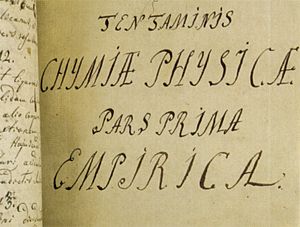Physical chemistry facts for kids
Physical chemistry is a science that mixes ideas from physics and chemistry. It helps us understand how chemicals behave and why they do what they do. This field looks at things from very tiny particles, like atoms, to much larger groups of them. It uses concepts like energy, force, and how things move to explain chemical changes.
Physical chemistry often studies the properties of large amounts of materials, not just individual atoms or molecules. For example, it helps us understand why some liquids stick together or how fast a chemical reaction happens.
Contents
What Physical Chemists Study
Physical chemists try to figure out how different things affect chemicals. They look at:
- How tiny forces between molecules change a material's properties, like how strong it is or how easily it can be shaped.
- How fast chemical reactions happen. This is called chemical kinetics.
- How the type of tiny charged particles (ions) affects how well a material conducts electricity.
- What happens at the surface of materials, like in cell membranes.
History of Physical Chemistry
The words "physical chemistry" were first used by a scientist named Mikhail Lomonosov. He used the term in 1752 when he taught a class at Petersburg University.
Modern physical chemistry really started to grow in the late 1800s. Scientists began to study how heat affects chemical reactions (called chemical thermodynamics). They also looked at how electricity moves through liquids and how fast chemical reactions occur.
In 1876, Josiah Willard Gibbs wrote an important paper. It introduced many key ideas, like Gibbs free energy, which helps explain why reactions happen. Other scientists, like Heike Kamerlingh Onnes, also made big discoveries about energy changes.
The first science magazine just for physical chemistry started in Germany in 1887. It was created by Wilhelm Ostwald and Jacobus Henricus van 't Hoff. These two, along with Svante Arrhenius, were very important in this field. They all won the Nobel Prize in Chemistry for their work.
Many more discoveries happened in the 1900s. Scientists started using statistical mechanics to understand chemical systems. Irving Langmuir studied how tiny particles mix in liquids (called colloids) and what happens on surfaces. In the 1930s, Linus Pauling and others used quantum mechanics to create quantum chemistry. This helped explain how atoms and molecules bond.
New ways to study chemicals also appeared in the 20th century. These included different types of spectroscopy, which uses light to learn about materials. Physical chemistry also helped with discoveries in nuclear chemistry, especially during World War II. Later, chemists even used physical chemistry to learn about chemicals in space, a field called astrochemistry.
Branches of Physical Chemistry
Physical chemistry covers many different areas. Some of them include:
- Thermochemistry: Studying heat changes in chemical reactions.
- Chemical kinetics: How fast chemical reactions happen.
- Quantum chemistry: Using quantum mechanics to understand atoms and molecules.
- Electrochemistry: How electricity and chemical reactions are linked.
- Photochemistry: How light affects chemical reactions.
- Surface chemistry: What happens on the surfaces of materials.
- Solid-state chemistry: Studying the chemistry of solid materials.
- Spectroscopy: Using light to study materials.
- Biophysical chemistry: Combining physics, chemistry, and biology.
- Materials science: Creating and studying new materials.
- Physical organic chemistry: Using physical chemistry ideas to understand organic reactions.
- Micromeritics: Studying tiny particles.
Images for kids
-
Between the flame and the flower is aerogel, whose synthesis has been aided greatly by physical chemistry
See also
 In Spanish: Fisicoquímica para niños
In Spanish: Fisicoquímica para niños



